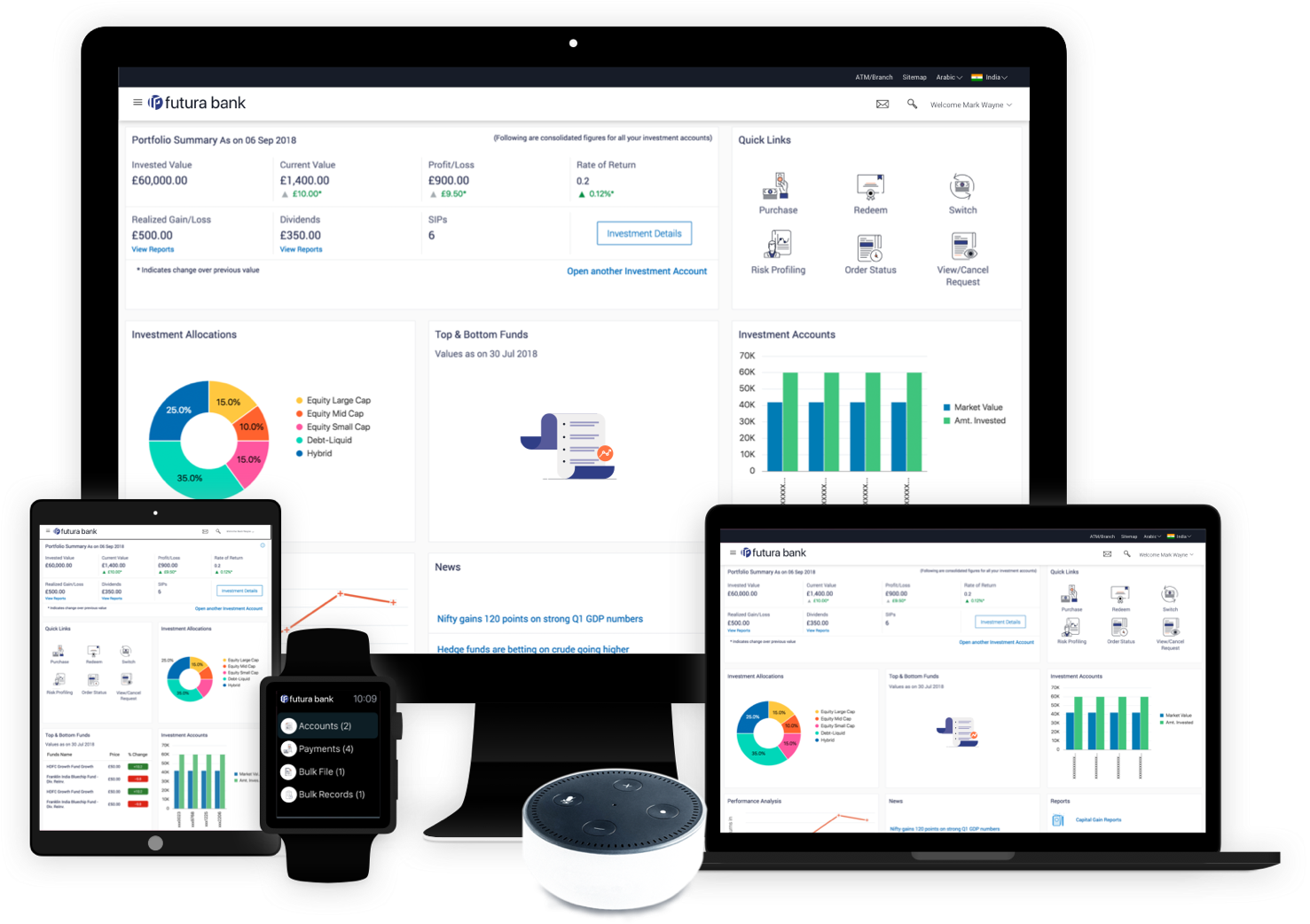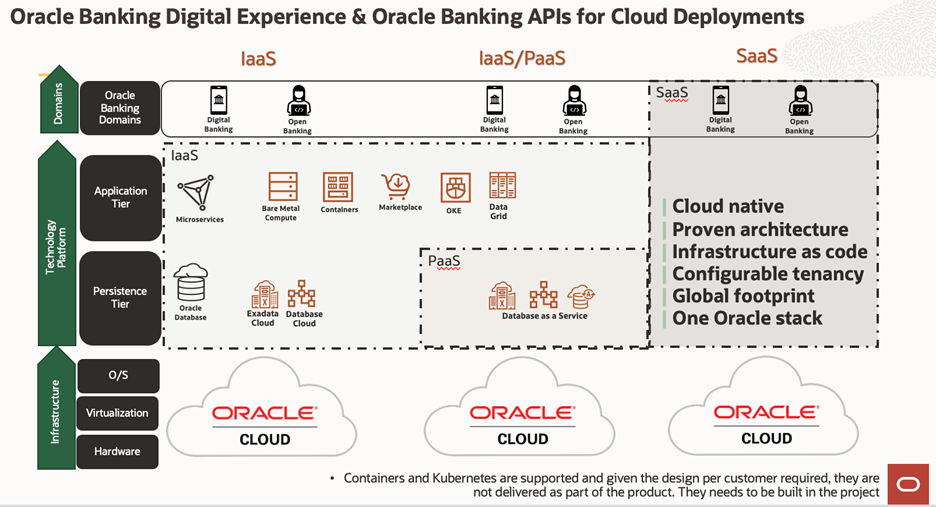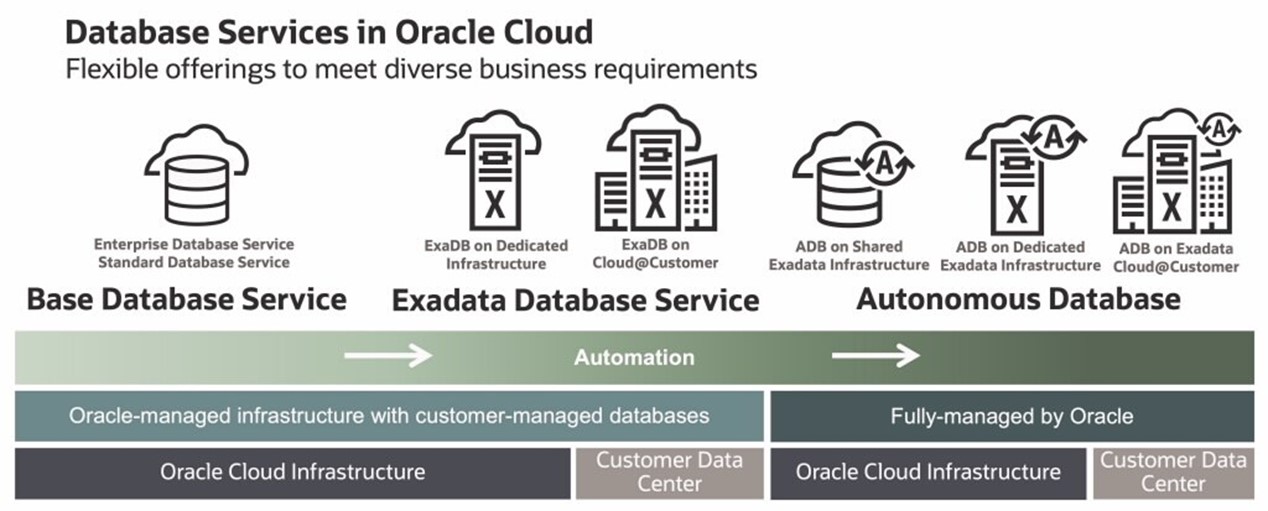The authors would like to thank Larry Wong for his contributions to this blog.
Oracle Banking Digital Experience (OBDX) is a digital banking solution that provides ready-to-go retail, corporate, and Islamic banking experiences across multiple channels while integrating with a banks existing system for core banking. When considering the practice of modernizing technology for financial services organizations, one-size-fits-all isn’t always applicable. This statement is especially true for banking applications because each bank has a unique strategy. Many factors influence the decision of an on-premises deployment or a cloud-based deployment and whether to use platform as a service (PaaS) or infrastructure as a service (IaaS).

According to the Project Management Institute (PMI), every project is unique. Customers should have a choice when deciding how to implement banking solutions. Adapting the statement into the financial services industry, choosing the deployment model is all about context.
Which model to choose for your context
So, which model is ideal for delivering a scalable reliable digital banking platform and one that offers the best customer experience? The answer is in the context. The following sections cover situations that apply to why customers need different deployment options.
On-premises
- Geography: Some customers operate in countries and areas not covered by cloud providers.
- Infrastructure: International data centers and underdeveloped regions face operational challenges with backbone communications.
- Regulations: Some regulations have strict rules on the location of data, processing of data and might require that no data can leave a jurisdiction.
- Ecosystem: Heavy requirements on integrations with services on-premises lead to high latency and poor customer experience with the cloud model.
PaaS and IaaS cloud
- Cost-effectiveness: Banks can have initiatives to transition from capital expenditures (CAPEX) to operating expenses (OPEX) and to use pay-as-you-go models for hardware needs.
- Future-proofing: Banks need access to state-of-the-art data center infrastructure stack. Various technologies are needed, from hardware to operating systems and from databases to analytic tools.
- Data residency: Retain full control of data and application to meet the highest security, regulatory, and data residency requirements.
- Time saving: Efficiency in the implementation and maintenance of workloads can be critical.
- Speed to market: Banks might need a quick go-to-market strategy and the ability to make agile releases.
- Scalability and resilience: Scalability needs to be flexible and efficient in cost. In addition, the availability and reliability of systems must be assured.
Software-as-a-service (SaaS) cloud
- Accessibility: Banks might need immediate access to the latest software improvements and features without development cycle delay.
- Operational cost: Banks can require no upfront license fees and no other capital cost add-ons.
- Cost-effectiveness: Banks might prefer simplified payment models to keep costs predictable for budgeting.
- Scalability: They might need architecture designed for growth that can scale with little to no disruption.
- Analytics: Banks might want built-in reporting and intelligence tools and machine learning (ML) and artificial intelligence (AI) capabilities.
- Security: When minimal security responsibility is preferred.
Enter Oracle Banking Digital Experience
Can you deploy OBDXin any one of these service models? Yes! Customers can choose to deploy OBDX in its different forms, considering their unique context. While you can deploy OBDX on-premises or on other cloud providers, this article explores the options and variations of deployment that differentiate Oracle Cloud Infrastructure (OCI).
Let’s look at required layers of deployment for OBDX in each model. Then we can cover the deployment models and see the differentiations among each.
- Infrastructure tier: Where the hardware, virtualization, and operating system that power OBDX live, it works the same across the three cloud service models (IaaS, PaaS, and SaaS).
- Technology or persistence tier: This tier holds the database technologies. The implementation is slightly different between the IaaS and PaaS models. With the SaaS model, implementation isn’t required.
- Technology, application, and web tier: This tier houses application-related technologies, including application servers, web servers, and any containerization needs. The IaaS and PaaS implementation requirements are the same, while SaaS has no implementation requirements.
- Domain or client tier: This tier is the same across each deployment style. Supported clients are web browsers, mobile apps, and API consumers. The chosen deployment model is abstracted from end-users.

Cloud service models
With infrastructure as a service, customers can use the OCI Gen 2 cloud to deploy OBDX on a cloud designed to run applications securely and cost-efficiently and with optimum performance. Deploying OBDX with the IaaS model requires knowledge of OCI services related to networking, compute, storage, and databases. It also requires an understanding of data residency requirements that might exist to choose IaaS in a public or private cloud with equivalent services in each.
Customers can create virtual cloud networks (VCNs), flexible load balancers, and even use API gateways to service all the network requirements of OBDX. With the Compute service, customers have various shapes that they can provision for self-service using the specifications they want. After they provision the Compute instances on the VCN and attach OCI Block Volume storage, they can install the OBDX application software.
You can deploy the latest versions of WebLogic middleware from the Oracle Cloud Marketplace. You can also use a container version of WebLogic with Oracle Container Engine for Kubernetes (OKE). Customers can integrate WebLogic with Oracle Coherence, which provides fault-tolerant data caching and supports millions of simultaneous users with speed and efficiency.
You can install Oracle Database software directly on Compute shapes or use the IaaS and PaaS models. You can automate most steps in the IaaS deployment model with infrastructure as code (IAC).
IaaS implementations have the following benefits:
- Control most of the technical estate and customize environment according to your business needs.
- Stop or increase resources instead of buying physical hardware.
- Future-proof stacks with cutting edge infrastructure.

With the hybrid IaaS and PaaS service model, deployment is like the IaaS model. All steps are the same except for database deployment. Customers can deploy the OBDX database based on their requirements with Database Cloud service, Exadata Cloud service or Autonomous Database.
Database cloud service gives you an option to provision an Oracle database version of your choice without any installation or OS configuration. You can also use the Database Cloud service to provision Real Application Clusters (RAC) for maximum availability.
The Exadata Cloud service option offers RAC, the latest Oracle Database versions, and provides high performance and availability with hardware designed for Oracle databases. You can also use the world’s only autonomous database. Oracle Autonomous Database is a cloud database that uses machine learning (ML) to automate database tuning, security, backups, updates, and other routine management tasks traditionally performed by database administrators. Unlike a conventional database, an autonomous database performs all these tasks and more without human intervention. You can deploy IaaS and Paas in OCI Dedicated Region, enabling clients to meet governance, regulatory compliance, and data privacy requirements while experiencing the full benefits of the public cloud.
Hybrid PaaS and IaaS implementations have the following benefits:
- Reduced cost of technical maintenance for hardware, OS, and database patches
- Reduced operational cost with Autonomous Database and application images.
- High availability and performance with Real Application Clusters
In the SaaS deployment model, OBDX functions the same as in other models but with more SaaS benefits. Customers can reduce the amount of IT time spent on OBDX with decreased technical responsibility required in the SaaS model. You can rest assure that OBDX has availability backed by service level agreements (SLAs) and that the infrastructure and technology layers are completely abstracted.
Behind the scenes, OBDX is deployed in a highly scalable architecture with a business continuity plan for each customer. You can deliver OBDX in environments isolated for developement, QA, and production. You can also facilitate OBDX application integration with services such as Oracle Integration Cloud, Oracle Analytics Cloud, and more.
SaaS implementations offer the following benefits:
- Experience equivalent performance and security as with the IaaS and PaaS deployment model.
- Reduce risk with a lower technical and security responsibility.
- Gain immediate access to the latest improvements without need for installation or patching.
Conclusion
You have multiple options for deploying OBDX, and you decide which option fits the context of your strategy. Each option equips you with a cloud that’s global, secure, fast, and built with next-generation infrastructure when you run Oracle Banking Digital Experience on Oracle Cloud Infrastructure.
To learn more, see the following resources:

